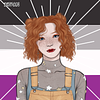You need to sign in or sign up before continuing.
Take a photo of a barcode or cover
Moderate: Racism, Slavery, Terminal illness, Violence, War
Minor: Homophobia
Graphic: Death, Gun violence, Miscarriage, Terminal illness, Violence, Blood, Vomit, Death of parent, Pregnancy, Injury/Injury detail
Moderate: Biphobia, Homophobia, Misogyny, Sexism, Lesbophobia, War
Minor: Infidelity, Sexual assault, Slavery, Suicidal thoughts, Religious bigotry, Dysphoria
Graphic: Body horror, Cancer, Death, Miscarriage, Misogyny, Sexism, Terminal illness, Violence, Abortion, Pregnancy, War
Moderate: Alcoholism, Animal death, Confinement, Infidelity, Slavery, Blood, Grief, Alcohol, Colonisation, Injury/Injury detail
I kind of wish Mary drove more of the plot herself - sometimes it felt like she was an observer rather than an actor in the story - but her descriptions and observations of the world around her were completely immersive.
This is a nice long read that trusts itself and doesn’t rush. First mention of pirates: page 140
Graphic: Animal death, Child death, Death, Gore, Miscarriage, Rape, Sexual assault, Sexual violence, Violence, Blood, Vomit, Pregnancy, War, Injury/Injury detail
Moderate: Homophobia, Misogyny, Racial slurs, Racism, Slavery
We follow the story of Mary Read, one of history's most famous female pirates. The first few chapters move quite fast through her childhood and adolescence. Her mother makes her take on her dead brother's name to keep receiving an allowance and later to open up more possibilities of earning money. This way, Mary makes her way from serving at a big house, to the navy, to the army, all while being "Mark" to everyone but her mother.
It feels like she lives an entire life (including marriage and pregnancy) before she even starts her "career" as a pirate and meets Anne Bonny and Jack Rackham.
The historical accounts about Mary Read are not very extensive. As a consequence, the book contains some historical inaccuracies or simply parts that were made up, as the author remarks herself at the end. I also really appreciated the writing style; it was beautiful yet still didn't try to conceal anything ugly. Mary is not a well-mannered lady, and thus her language is at times crude, but it only contributes to the atmosphere, in my opinion.
I'm only deducting half a star because the middle was a bit slow for me, and I had some trouble staying consistently reading. (It was mostly the part where she lives with her husband because I could tell Mary was bored, so I also got a bit passive about it.)
Graphic: Death, Miscarriage, Violence
Moderate: Sexual assault, Slavery, Sexual harassment
Minor: Terminal illness, Death of parent
However, I absolutely loved this book.
It's exploration of gender & queerness was fabulous.
Set between the late 16 & 17 hundreds it follows Mary (Mark) Read, a woman raised as a boy who who enrolls in the Navy and 16 and later joins the army. Later in her life she becomes a pirate, you follow her whole life through the book. Mary Read was a real female pirate, this book is based off historical papers woven into fiction.
Gorgeous story, I don't want to give too much away. It's a great, great, book!
Graphic: Torture, Violence, Blood, Vomit, War
Moderate: Cancer, Gore, Mental illness, Miscarriage, Misogyny, Sexual assault, Slavery, Outing, Injury/Injury detail
Graphic: Death, Sexism, Violence, Murder, Injury/Injury detail
Moderate: Child death, Homophobia, Miscarriage, Sexual assault, Slavery, Kidnapping, Sexual harassment, Colonisation
This book grew on me as I read it and I'd put it somewhere between 4-4.5 stars. It wasn't at all what I was expecting but I enjoyed it anyway.
That being said, it took me a while to really get into this book and for it to really grab my attention. The short scene cuts annoyed the hell out of me at the beginning. I didn't really see their point or use as I’m someone who likes a lot of detail in the books I read and description (but not Nathaniel Hawthorne describe a door for 2 pages level).
But midway through reading the book, I realized why the author does the short scene cuts and why they're so plentiful in the early ages of Mary's life and there's not as much description. It’s a clever way to show memory and tell a story. If you look over the whole book, the beginning is less detailed descriptions of people because Mary just can’t remember them. Towards the end/her present, the descriptions get better because it’s more recent and fresh in her own memory.
It was advertised as a very queer book and about Anne Bonny and Mary Read. While it is queer and Anne Bonny is a significant character, neither of those are the focus or often referenced in the book. Anne Bonny isn't even mentioned until p. 145. Gender identity is discussed quite often in the story (Mark vs. Mary, etc.) but sexuality (especially Mary's interest in women), isn't addressed until p. 204 and nothing happens between Mary and another woman until p.256.
I quite enjoyed Crow as a character and her constant companionship.
Book was recommended to me by the owner of Artemis Books in Aachen, where it was also purchased.
Graphic: Child death, Death, Gore, Gun violence, Infidelity, Miscarriage, Misogyny, Racism, Sexism, Sexual content, Violence, Blood, Medical content, Kidnapping, Grief, Murder, Alcohol, Sexual harassment, Colonisation, War, Injury/Injury detail, Classism
Graphic: Death, Homophobia, Miscarriage, Sexism, Sexual content, Slavery, Terminal illness, Violence, Blood, Grief, Death of parent, War, Injury/Injury detail
Graphic: Animal death, Child death, Death, Physical abuse, Sexism, Sexual assault, Blood, Grief, Pregnancy, Alcohol
Moderate: Terminal illness, Violence, Vomit, Lesbophobia, Colonisation








